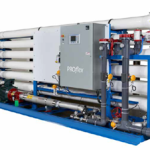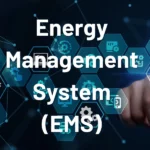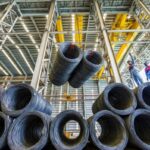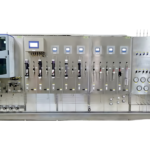In today’s market, using pure and safe water is an essential factor in various industrial sectors. One of the most advanced solutions to meet this need is the RO EDI demineralization system, also known as the RO EDI water purification system (Reverse Osmosis Electrodeionization).
This system is not just a simple water filtration tool, but also an advanced technology that provides highly pure and safe water for a variety of uses in the industry, ranging from semiconductor, electronics, and pharmaceutical manufacturing to applications in the medical and research fields.
By combining reverse osmosis (RO) and electrodeionization (EDI), the RO EDI system not only efficiently removes minerals and impurities from water but also produces pure water with extremely low electrical conductivity and ion content, perfectly meeting the needs of applications that demand high levels of purity.
What is the EDI water purification system?
The EDI water purification system (Electrodeionization) is an electric-controlled water treatment technology that utilizes electricity, ion exchange membranes, and resin to remove various ionized substances from water.
The EDI water purification system (Electrodeionization) is an advanced water treatment technology that uses electricity, ion exchange membranes, and resin beads to remove ions and charged particles from water optimally. This is a leading choice in industries requiring high-purity water sources, such as semiconductor, pharmaceutical, and medical production.
The strength of the EDI system lies in its ability to efficiently remove dissolved mineral salts, organic acids, and other ions, raising the quality of the output water up to 90-95%.
The EDI process operates continuously and automatically, combining several components:
- Ion exchange membrane: Separates positively charged metal ions (cations) and negatively charged non-metal ions (anions) from the water stream.
- Resin beads: Retain ions separated by the ion exchange membrane.
- Electric field: Generates force to move the ions through the membrane and resin beads, ensuring continuous filtration.
Compared to traditional ion exchange methods, the EDI system offers superior advantages through its continuous electricity regeneration, eliminating the need for hazardous chemicals. Furthermore, EDI also conserves wastewater and operational costs, making it more environmentally friendly.
The EDI water purification system is often used with reverse osmosis technology (RO) to produce highly pure water with extremely low electrical conductivity, meeting the stringent quality requirements in industries demanding high-purity water.
How does Electrodeionization (EDI) work?
The EDI module consists of a series of chambers filled with ion exchange resin and separated by ion exchange membranes. Water enters the module, where an electric field is applied perpendicular to the flow, causing ions to move through the resins and across the membranes. These unwanted ions are not permanently bound to the environment; instead, they are collected in concentrate streams that can be directed to drain or recycled. The deionized product water can be used directly or undergo further treatment to enhance its purity.
The EDI module functions like an ion exchange bed continuously regenerated by electricity. As ions move through the resins and between cation or anion-selective membranes, they are exchanged for H+ and OH- ions. Ions that become bound to the ion exchange resins eventually move into a separate chamber under the influence of an externally applied electric field, which also produces the H+ and OH- ions needed to maintain the resins in their regenerated state. The ions in the separate chamber are expelled into a separate stream with no replenishment.
EDI’s limitations differ from traditional ion exchange. In the latter case, the ion purity of the product water is limited by the total number of ions absorbed by the resins. The maximum throughput of ion flux limits EDI. An excessive ion concentration will tend to overload the module. Therefore, EDI is typically used following reverse osmosis and with very hard water, degassing may be necessary to remove carbon dioxide.
Operation process of the RO EDI water treatment system
The EDI demineralization system operates as follows:
Step 1: The source water (tap water) must be treated for hardness, removing iron, chlorine, manganese, arsenic, and other contaminants.
Step 2: Water passes through five filtration columns:
- Multi-layer filter: Contains quartz sand and manganese ore to remove heavy metals and suspended solids from the water.
- Carbon filter: Contains activated carbon from coconut shells (ideally Norit PK1-3) to absorb residual chlorine, organic compounds, and odors in the water.
- Ion exchange column: Contains cation resin beads that absorb calcium and magnesium, reducing the water’s hardness to meet soft water standards.
- Cartridge filter: Uses a 5µm filter cartridge to remove suspended solids in the EDI system, protecting the RO membrane.
- RO membrane: The RO membrane uses reverse osmosis technology, which employs gravitational forces to create the osmosis of molecules through the membrane’s microcapillaries. The RO membrane can remove 99.99% of bacteria and viruses, chemical components, metal impurities, and organic compounds with molecular weights over 300 or particles about 0.001 microns in size.
Step 3: The water then passes through the RO membrane and continues through the EDI equipment to reduce the electrical conductivity to 0.1µS/cm.
Step 4: The final step is sterilization, where UV lights or ozone generators are used to eliminate any bacteria that may arise in the pipes and through antibacterial filter cartridges.
Once the process is complete, the water is directed into a storage tank for use in electronics, pharmaceuticals, and other industries.
Applications of RO EDI technology in life
RO EDI technology is increasingly being applied in many areas of life, providing practical benefits for people. Here are some prominent applications:
1/ Providing purified water for daily use:
-
-
- Completely removes impurities, bacteria, viruses, heavy metals, and harmful chemicals, providing pure and safe water for health.
- The filtered water can be consumed directly without boiling, saving time and energy.
- Enhances the taste of water, helping you enjoy the freshness and purity in every sip.
-
2/ Applications in healthcare:
-
-
- Provides purified water for medicine production and medical solutions, ensuring safety and effectiveness for the treatment process.
- Sterilizes medical instruments, helping prevent cross-contamination and protecting patients’ health.
- Supplies clean water to clinics and hospitals, ensuring hygiene and safety for the medical environment.
-
4/ Applications in industrial production:
-
-
- Provides purified water for semiconductor, electronics, and microchip manufacturing, ensuring product precision and quality.
- Used in food and beverage production, cosmetics, and other industries to enhance product quality and ensure food safety.
- Supplies water to other industries such as textiles, chemicals, and printing.
-
5/ Applications in laboratories:
-
- Provides purified water for scientific experiments, ensuring accuracy and reliability for research results.
- Cleans laboratory equipment, helping remove impurities and microorganisms, ensuring purity for experiments.
In addition, RO EDI technology is also applied in other areas such as:
- Agriculture: Irrigation for crops, helping increase productivity and quality of agricultural products.
- Aquaculture: Provides clean water for ponds, helping increase survival rates and quality of fry.
- Household use: Provides clean water for cooking, laundry, and bathing, protecting health and improving quality of life.
With outstanding advantages in efficiency and safety, RO EDI technology is becoming the optimal solution for the need to use purified water in many areas of life.
Conclusion
Today, the demand for pure and safe water is becoming increasingly important and indispensable in many industrial sectors and daily life. The RO-EDI (Reverse Osmosis Electrodeionization) system has emerged as an advanced and effective solution to meet this need.
By combining reverse osmosis (RO) and electrodeionization (EDI), the RO-EDI system not only efficiently removes minerals and impurities from water but also produces purified water with extremely low electrical conductivity and ion content. This has made the system a top choice in industries requiring high-purity water sources such as semiconductor, pharmaceuticals, and healthcare.
The EDI system’s ability to efficiently remove dissolved mineral salts, organic acids, and other ions has increased the quality of output water up to 90-95%. Its continuous and automated operation also brings convenience and high efficiency to users.
Moreover, compared to traditional ion exchange methods, the RO-EDI system offers superior advantages such as continuous regeneration using electricity and no use of hazardous chemicals. This not only minimizes wastewater and operational costs but also demonstrates environmental protection.
In short, the RO-EDI demineralization system not only meets the need for pure and safe water use in industries but also brings significant benefits to people’s daily lives. With diverse potential and applications, this technology is increasingly asserting its position in the current water treatment market.
For further consultation on the EDI water treatment system, please contact EEG for the best advice.






